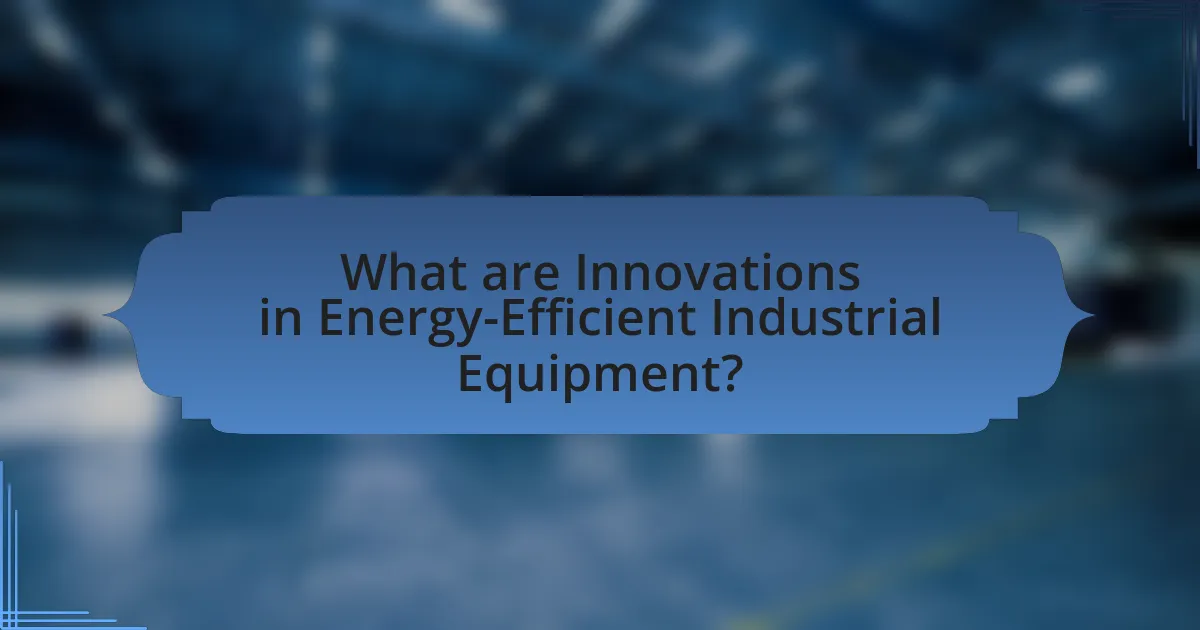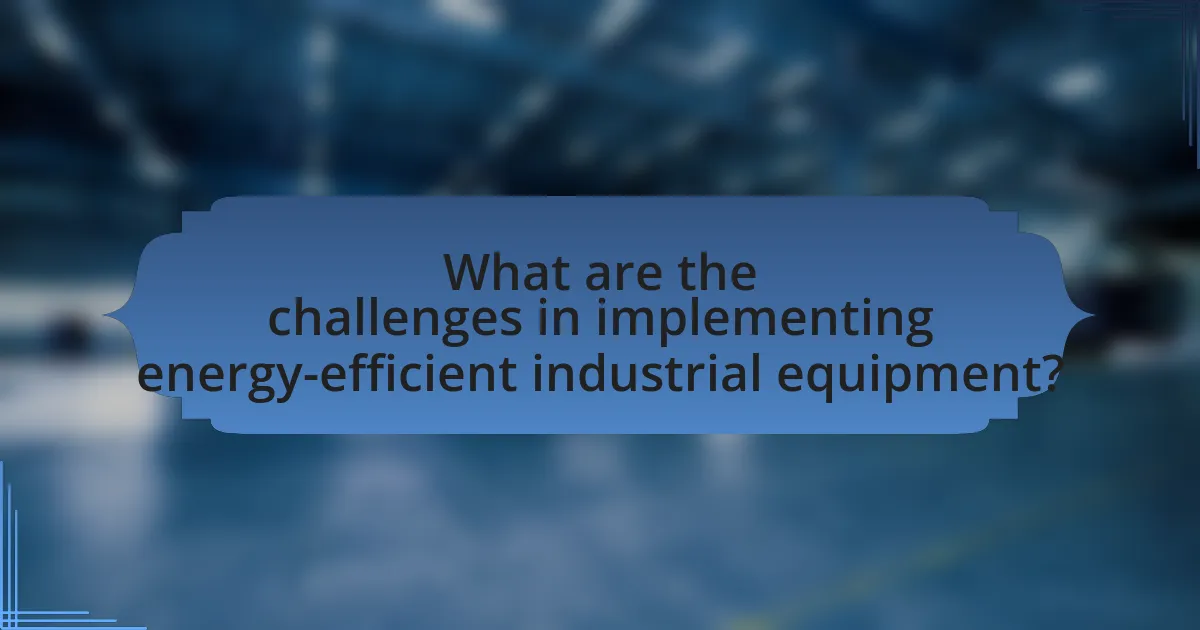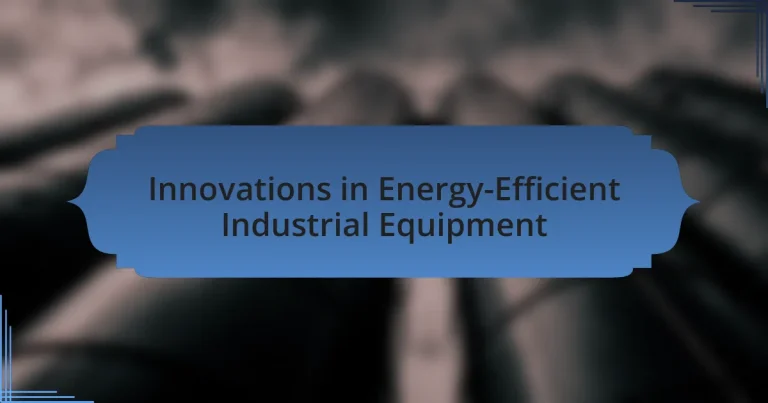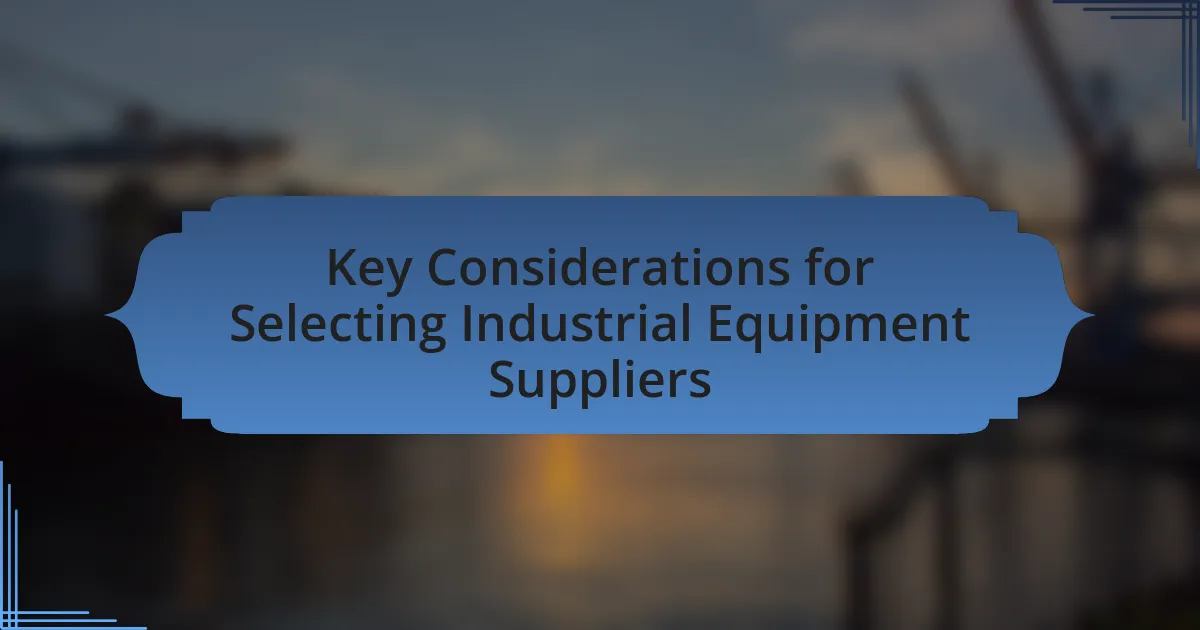Innovations in energy-efficient industrial equipment encompass advanced technologies such as variable frequency drives (VFDs), energy-efficient motors, and smart sensors, which collectively reduce energy consumption and operational costs. These technologies enhance industrial operations by improving productivity, minimizing downtime, and aligning with sustainability goals through reduced greenhouse gas emissions. Key features of energy-efficient equipment include high efficiency ratings, real-time monitoring capabilities, and integration with renewable energy sources, all contributing to significant energy savings. The article also addresses the challenges industries face in adopting these technologies, including financial constraints and resistance to change, while highlighting best practices for successful implementation and performance tracking.
What are Innovations in Energy-Efficient Industrial Equipment?

Innovations in energy-efficient industrial equipment include advanced technologies such as variable frequency drives (VFDs), energy-efficient motors, and smart sensors. These innovations significantly reduce energy consumption and operational costs. For instance, VFDs adjust motor speed to match load requirements, leading to energy savings of 20-50% in applications like pumps and fans. Energy-efficient motors, designed to meet or exceed efficiency standards set by organizations like the U.S. Department of Energy, can achieve efficiency levels above 95%. Additionally, smart sensors enable real-time monitoring and optimization of energy use, further enhancing efficiency. These advancements collectively contribute to a more sustainable industrial sector by minimizing energy waste and lowering greenhouse gas emissions.
How do these innovations impact industrial operations?
Innovations in energy-efficient industrial equipment significantly enhance industrial operations by reducing energy consumption and operational costs. These advancements lead to improved productivity, as equipment operates more efficiently, minimizing downtime and maintenance needs. For instance, the implementation of energy-efficient motors can reduce energy use by up to 50%, directly impacting the bottom line of manufacturing processes. Additionally, these innovations contribute to sustainability goals by lowering greenhouse gas emissions, aligning with regulatory requirements and corporate social responsibility initiatives.
What specific technologies are driving these innovations?
Specific technologies driving innovations in energy-efficient industrial equipment include advanced sensors, artificial intelligence, and IoT (Internet of Things) integration. Advanced sensors enable real-time monitoring of equipment performance, leading to optimized energy usage. Artificial intelligence algorithms analyze data from these sensors to predict maintenance needs and enhance operational efficiency. IoT integration facilitates seamless communication between devices, allowing for automated adjustments that further reduce energy consumption. These technologies collectively contribute to significant energy savings and improved operational efficiency in industrial settings.
How do these technologies improve energy efficiency?
Innovations in energy-efficient industrial equipment improve energy efficiency by utilizing advanced technologies such as automation, smart sensors, and energy management systems. These technologies optimize energy consumption by monitoring real-time usage, adjusting operations based on demand, and minimizing waste. For example, smart sensors can detect when machinery is not in use and automatically shut it down, leading to significant energy savings. According to a report by the U.S. Department of Energy, implementing energy-efficient technologies can reduce energy consumption in industrial settings by up to 30%.
Why is energy efficiency important in industrial settings?
Energy efficiency is crucial in industrial settings because it significantly reduces operational costs and environmental impact. By optimizing energy use, industries can lower their energy bills, which can account for a substantial portion of total operating expenses; for example, energy costs can represent up to 30% of manufacturing expenses. Additionally, improved energy efficiency leads to reduced greenhouse gas emissions, contributing to sustainability goals and compliance with environmental regulations. According to the U.S. Department of Energy, implementing energy-efficient technologies can reduce energy consumption in industrial facilities by 10-30%, showcasing the tangible benefits of energy efficiency initiatives.
What are the environmental benefits of energy-efficient equipment?
Energy-efficient equipment significantly reduces greenhouse gas emissions, contributing to a healthier environment. By consuming less energy, these devices lower the demand for electricity, which is often generated from fossil fuels. For instance, the U.S. Department of Energy reports that energy-efficient appliances can reduce energy consumption by 10-50%, leading to a decrease in carbon dioxide emissions. Additionally, energy-efficient equipment often uses fewer resources in manufacturing and operation, further minimizing environmental impact. This reduction in energy use not only conserves natural resources but also decreases air and water pollution associated with energy production.
How does energy efficiency affect operational costs?
Energy efficiency significantly reduces operational costs by lowering energy consumption in industrial processes. When equipment operates more efficiently, it requires less energy to perform the same tasks, leading to decreased utility bills. For instance, according to the U.S. Department of Energy, energy-efficient industrial equipment can reduce energy use by 10% to 50%, translating into substantial cost savings over time. Additionally, improved energy efficiency often results in lower maintenance costs and extended equipment lifespan, further contributing to reduced overall operational expenses.
What types of energy-efficient industrial equipment are available?

Energy-efficient industrial equipment includes variable frequency drives (VFDs), energy-efficient motors, LED lighting systems, high-efficiency boilers, and heat recovery systems. These types of equipment are designed to reduce energy consumption and operational costs while maintaining productivity. For instance, VFDs can adjust motor speed to match load requirements, leading to energy savings of 20-50%. Energy-efficient motors can achieve efficiency ratings of 95% or higher, significantly lowering energy use compared to standard motors. Additionally, LED lighting systems consume up to 75% less energy than traditional lighting, contributing to overall energy efficiency in industrial settings. High-efficiency boilers can operate at 90% efficiency or more, reducing fuel consumption and emissions. Heat recovery systems capture waste heat from industrial processes, allowing for reuse in heating applications, further enhancing energy efficiency.
How do different types of equipment contribute to energy efficiency?
Different types of equipment contribute to energy efficiency by utilizing advanced technologies and design features that minimize energy consumption while maximizing output. For instance, variable frequency drives (VFDs) in motors adjust the speed and torque according to demand, leading to energy savings of 20-50% compared to traditional fixed-speed motors. Additionally, energy-efficient lighting systems, such as LED fixtures, consume up to 75% less energy than incandescent bulbs, significantly reducing overall energy usage in industrial settings. Furthermore, high-efficiency boilers and chillers are designed to operate at optimal performance levels, achieving energy savings of 10-30% over standard models. These innovations collectively enhance energy efficiency by reducing waste and lowering operational costs, thereby contributing to more sustainable industrial practices.
What are the key features of energy-efficient motors?
Energy-efficient motors are designed to minimize energy consumption while maintaining performance. Key features include high efficiency ratings, typically above 90%, which reduce energy losses during operation. These motors often utilize advanced materials, such as high-grade electrical steel, to enhance magnetic performance and reduce heat generation. Additionally, they incorporate improved design elements like optimized rotor and stator configurations, which contribute to lower operational costs. Many energy-efficient motors also feature variable frequency drives (VFDs) that allow for precise control of motor speed and torque, further enhancing energy savings. According to the U.S. Department of Energy, using energy-efficient motors can lead to energy savings of 20-50% compared to standard motors, validating their effectiveness in reducing energy consumption.
How do advanced HVAC systems enhance energy savings?
Advanced HVAC systems enhance energy savings by utilizing smart technology and efficient design to optimize heating, cooling, and ventilation processes. These systems often incorporate features such as variable speed drives, advanced sensors, and automated controls that adjust operation based on real-time demand, significantly reducing energy consumption. For instance, studies show that implementing variable refrigerant flow technology can lead to energy savings of up to 30% compared to traditional systems. Additionally, advanced HVAC systems often include energy recovery ventilators that reclaim energy from exhaust air, further improving overall efficiency.
What role do renewable energy sources play in industrial equipment?
Renewable energy sources play a crucial role in powering industrial equipment by providing sustainable and cost-effective energy alternatives. These sources, such as solar, wind, and biomass, reduce reliance on fossil fuels, leading to lower greenhouse gas emissions and operational costs. For instance, a study by the International Renewable Energy Agency (IRENA) found that integrating renewable energy into industrial processes can reduce energy costs by up to 30% while enhancing energy security. This shift not only promotes environmental sustainability but also drives innovation in energy-efficient technologies, enabling industries to meet regulatory standards and consumer demand for greener practices.
How can solar energy be integrated into industrial operations?
Solar energy can be integrated into industrial operations through the installation of photovoltaic (PV) systems on rooftops and unused land, enabling facilities to generate their own electricity. This integration reduces reliance on fossil fuels, lowers energy costs, and minimizes carbon footprints. For instance, a study by the National Renewable Energy Laboratory found that industrial facilities could offset up to 30% of their energy consumption with solar power, demonstrating significant potential for cost savings and sustainability.
What are the benefits of using wind energy in manufacturing?
Using wind energy in manufacturing significantly reduces operational costs and carbon emissions. Wind energy is a renewable resource that can lower electricity expenses, as it is often cheaper than fossil fuels. According to the U.S. Department of Energy, the levelized cost of wind energy has dropped by 70% since 2009, making it a financially viable option for manufacturers. Additionally, utilizing wind energy helps companies meet sustainability goals, as it contributes to a reduction in greenhouse gas emissions, aligning with global efforts to combat climate change. This transition not only enhances a company’s public image but can also lead to increased customer loyalty and market competitiveness.
What are the challenges in implementing energy-efficient industrial equipment?

The challenges in implementing energy-efficient industrial equipment include high initial costs, lack of technical expertise, and resistance to change within organizations. High initial costs can deter companies from investing in new technologies, as energy-efficient equipment often requires significant upfront capital. Additionally, many organizations may lack the necessary technical expertise to effectively integrate and maintain these advanced systems, leading to potential operational inefficiencies. Resistance to change is another major challenge, as employees and management may be hesitant to adopt new practices or technologies, fearing disruptions to established workflows. These factors collectively hinder the widespread adoption of energy-efficient solutions in industrial settings.
What barriers do industries face when adopting new technologies?
Industries face several barriers when adopting new technologies, including high initial costs, lack of skilled workforce, resistance to change, and insufficient infrastructure. High initial costs can deter investment in energy-efficient industrial equipment, as companies may struggle to justify the upfront expenditure despite long-term savings. The lack of a skilled workforce limits the ability to implement and maintain new technologies effectively, leading to underutilization. Resistance to change often stems from established practices and fear of disruption, making it difficult for organizations to transition to innovative solutions. Additionally, insufficient infrastructure can hinder the integration of new technologies, as existing systems may not support advanced equipment or processes. These barriers collectively impede the widespread adoption of energy-efficient innovations in industrial settings.
How can companies overcome financial constraints?
Companies can overcome financial constraints by implementing cost-saving measures and investing in energy-efficient technologies. By adopting energy-efficient industrial equipment, companies can significantly reduce operational costs, as these technologies often lead to lower energy consumption and maintenance expenses. For instance, a study by the U.S. Department of Energy found that energy-efficient motors can reduce energy use by 2-8% compared to standard motors, translating into substantial savings over time. Additionally, companies can explore financing options such as grants, loans, or partnerships that specifically support the adoption of innovative technologies, further alleviating financial pressures.
What are the common misconceptions about energy-efficient equipment?
Common misconceptions about energy-efficient equipment include the belief that it is always more expensive upfront, that it requires frequent maintenance, and that it is less powerful than traditional equipment. Many people assume that energy-efficient options come with a higher initial cost, but studies show that the long-term savings on energy bills often offset this expense, making them more cost-effective over time. Additionally, while some energy-efficient equipment may require specific maintenance, most modern designs are built for durability and low upkeep. Lastly, the notion that energy-efficient equipment lacks performance is incorrect; advancements in technology have led to high-efficiency models that perform as well as, or better than, their conventional counterparts.
How can industries measure the effectiveness of energy-efficient equipment?
Industries can measure the effectiveness of energy-efficient equipment by analyzing energy consumption data before and after installation. This involves using energy monitoring systems to track the kilowatt-hours used by the equipment, comparing it to the energy usage of previous, less efficient models. For instance, a study by the U.S. Department of Energy found that implementing energy-efficient motors can reduce energy consumption by 2-8% compared to standard motors. Additionally, industries can assess performance metrics such as output efficiency and operational costs, which provide a comprehensive view of the equipment’s impact on overall energy savings and productivity.
What metrics should be used to evaluate energy savings?
To evaluate energy savings, key metrics include energy consumption reduction, cost savings, return on investment (ROI), and payback period. Energy consumption reduction measures the decrease in kilowatt-hours used before and after implementing energy-efficient equipment. Cost savings quantify the financial benefits derived from reduced energy bills, while ROI assesses the profitability of energy-saving investments by comparing net savings to initial costs. The payback period indicates the time required to recover the initial investment through energy savings. These metrics provide a comprehensive framework for assessing the effectiveness of energy-efficient innovations in industrial equipment.
How can companies track performance over time?
Companies can track performance over time by implementing key performance indicators (KPIs) and utilizing data analytics tools. KPIs provide measurable values that reflect the efficiency and effectiveness of energy-efficient industrial equipment, allowing companies to assess progress against their goals. Data analytics tools, such as software for real-time monitoring and reporting, enable organizations to analyze trends, identify areas for improvement, and make informed decisions based on historical performance data. For instance, a study by the International Energy Agency found that companies using data analytics to monitor energy consumption can reduce energy costs by up to 20%, demonstrating the effectiveness of these tracking methods.
What best practices should industries follow when transitioning to energy-efficient equipment?
Industries should conduct a comprehensive energy audit before transitioning to energy-efficient equipment. This audit identifies current energy usage patterns and highlights areas for improvement, enabling informed decisions on which equipment to upgrade. Following the audit, industries should prioritize equipment that offers the highest energy savings and return on investment, as evidenced by studies showing that upgrading to energy-efficient technologies can reduce energy consumption by 20-50%. Additionally, industries should engage employees in the transition process through training and awareness programs, which have been shown to enhance the effectiveness of energy-saving initiatives. Finally, establishing a monitoring system to track energy usage post-implementation ensures that the expected savings are realized and maintained over time.
How can staff training enhance the effectiveness of new technologies?
Staff training enhances the effectiveness of new technologies by equipping employees with the necessary skills and knowledge to utilize these technologies efficiently. When staff members are trained, they become proficient in operating new systems, which leads to improved productivity and reduced errors. For instance, a study by the International Society for Technology in Education found that organizations that invest in comprehensive training programs see a 20% increase in technology adoption rates. This correlation demonstrates that well-trained staff can leverage new technologies to optimize processes, ultimately contributing to energy efficiency in industrial equipment.
What strategies can be employed for successful implementation?
Successful implementation of innovations in energy-efficient industrial equipment can be achieved through a combination of stakeholder engagement, thorough training programs, and continuous monitoring and evaluation. Engaging stakeholders, including employees, management, and suppliers, ensures that all parties are aligned with the goals and benefits of the new equipment, fostering a collaborative environment. Training programs equip employees with the necessary skills to operate and maintain the new technology effectively, which is critical for maximizing efficiency and minimizing downtime. Continuous monitoring and evaluation allow organizations to assess the performance of the equipment, identify areas for improvement, and make data-driven decisions to enhance energy efficiency further. These strategies are supported by case studies showing that companies that actively involve stakeholders and invest in training see a 20-30% increase in operational efficiency post-implementation.




